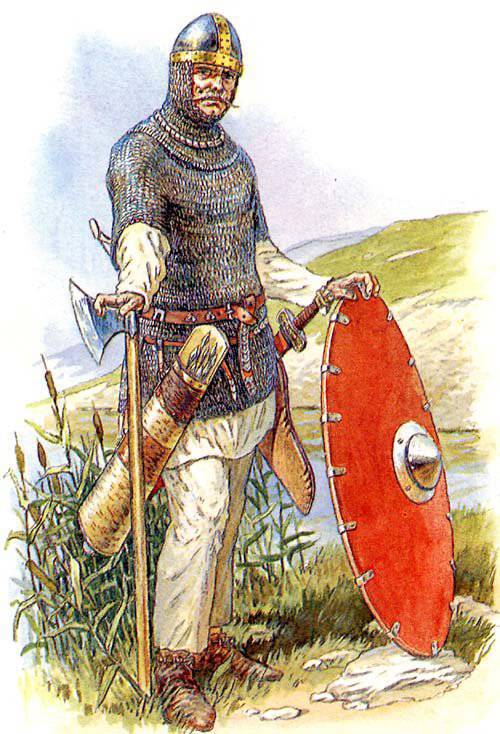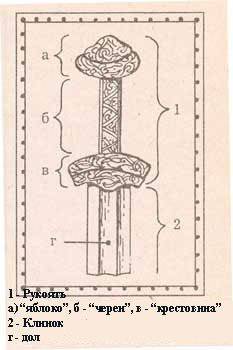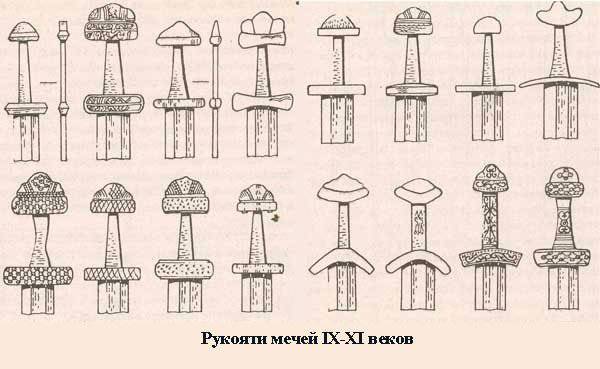Russian squads in battle. Part of 2

Russian epics are a very important source for identifying the psychology of Russian knights-knights. The image of a knight warrior - a heavily armed horse warrior, defender of the Fatherland, with his own ideas of honor, duty, with a certain pride (for some heroes, it comes to arrogance), gives rise to an association with Western European knighthood.
However, there is a serious difference, the Western knights are all noble people. Russian epics were the "product" of the common people. Most often the epic begins with the fact that the hero leaves the house, rich, like Dobrynia Nikitich, or a peasant, like Ilya. The reason that makes them leave their homeland is the desire to protect people, or “walk” (a very frequent motive). In the future, the hero boils unspent energy, he is "wild", Gumilev Passionate. Currently, such a person is called a person with an active lifestyle. The potential inherent in a person requires an exit.
In this regard, the difference between the epic heroes and the usual portrait of the Russian people, as he was portrayed by some historians or philosophers, like N. A. Berdyaev, no more passivity, femininity, immediately draws attention to itself. There was even a whole myth about the original passivity of the Slavs, who need the “Varangians”, the Germans, in order to lead and direct them. A sign of heroism is their activity, even rampage. This is one of the socio-psychological traits.
Another important feature of the Russian knight is the clear social orientation of his activities. He lives in the interests of society, the people. Even such an ancient character, endowed with many magical properties, like Volkh Vseslavich, who does not need anyone's care or praise, is no stranger to common interests. He starts his campaign “on the Indian kingdom, on the Tsar Saltyk Stavrulievich” because he “boasts — boasts: He wants to take Kiev-grad behind a shield”. In the Russian epic, the hero is not conceived of living outside popular, state interests. An ancient, full of mythical symbolism, the struggle with the Serpent Gorynych turns into retribution for the burned cities and the liberation of the people who were taken captive.
In the epics, to enter the squad, it is usually required to accomplish two feats. One (or several) bogatyr performs as he wishes on his way to Kiev, the other already has the character of a princely task. Often, the first feat has the character of simple boldness: Dobrynya just like that, with no particular purpose, enters the fight with the Serpent, crushes his cubs; Alyosha kills anyone who does not touch, sometimes a sleeping Neodolishcha happens. Princely assignments are already "socially useful" character. Dobrynya, for the second time, encounters the Serpent, rescuing the prince's niece, Zabava Putyatnu; Alyosha frees the capital city of Kyiv from Tugarin.
Patriotism in the epic epic is present not only in the form of conscious conviction, but also as a deep psychology that determines worldview. Participation in the affairs of the people for the hero is the meaning of life. The interest of the land of the Russian bogatyryu-vityazi is more important than the personal one (this distinguishes the heroes from many heroes of fairy tales who aspire only for their own well-being). So, Ilya overcomes personal dislike for Vladimir and resentment towards him in order to protect Kiev, ordinary people.
Another feature of the psychology of Russian knights is a sense of personal dignity and honor. The warriors are proud and "passionate", do not despise. Insult is not forgiven to anyone. Even such a wise man, in general, a calm hero, like Ilya, is very cool in matters of honor. Offended by the prince, he arranges a feast for the "goal of the erratic." Ilya fights with Dobrynya because of the fame of him as a great master of struggle.
The main features of the psychology of the heroes - activity, social orientation of their actions, deep patriotism and a sense of personal dignity, this is all a legacy of the era of the so-called. "Military democracy". In 10-13 vv. this era has not yet been forgotten, most of the population was free and armed. Before serfdom was still far away. Unfortunately, many spread the concept of the peasants of 18-19 centuries, to an earlier era. Each full member of the community, if necessary, participated in military operations. "Warriors", urban and rural militia neither differed in armament nor combat techniques from warriors. There were no clear social boundaries. In the lower part of the squad often replenished from the common people. Therefore, in warriors, heroes saw "their".
As V. Dolgov and M. Savinov write: “The people in epics remember first of all about themselves. The story of the princely warriors, warriors, knights of Holy Russia, is perceived as information not about the ancestors of the ruling class, but about the roots of the people as a whole. This is ... a socio-psychological portrait of the main part of the Russian society of the Old Russian state - “people”, full-fledged members of the community from whom the squad was formed - the heroic brotherhood. It is preserved by people's memory as a reminder of a free and noble past ”(Vadim Dolgov, Mikhail Savinov. The Brave of Old Russia. M, 2010).
Warrior Education
Warrior training began in childhood. I must say that it was very short then, in 15-16 years, a man was considered an adult, he could marry and begin an independent life. Boyarsky son in these years entered the squad.
The first frontier, which marked the growing up of a boy and his transition from the state of infancy to the state of a child, was in 2-3 of the year. He was honored with tonsure. Some ethnographers believe that this custom existed not only among the nobility, but also in all social strata. Sometimes this ceremony could coincide with another - landing on a horse. These customs go back to deep pagan antiquity and were in the nature of military age initiation (initiation). In a later period, a frankly pagan landing on a horse was ousted from life, and the tonsure rite, which is close to the Christian ritual in form, remained as “decent”. In the West, this ancient custom was transformed into a knightful ritual. In Russia, the boys, therefore, set up for the future, they were to become warriors.
From early childhood, children were taught to arms. Archaeologists often find children's wooden swords. Usually their form corresponded to the form of a real weapon of this era. It is necessary to pay attention to the fact that children's swords, daggers, spears and bows in Russia did not perform an entertaining task, like modern toys. Through the game, the boy got experience handling weapons. Wooden weapons could learn the techniques of battle as real. Children's weapons were necessary for the gradual learning of techniques, gaining skills, developing strength (for example, a blade made of oak, was comparable in weight to the present), dexterity.
In addition to weapons, a kit of a future warrior included a horse, boats, tops, sleds, balls of various sizes. They were necessary not only for entertainment, but also for the development of agility, coordination of movement. In addition, the children of the nobility from early childhood and got a real weapon - swords, daggers.
Did a special school (or several) of weapon and hand-to-hand fighting exist in Russia? This question was attempted by a person who specifically sought the traces of this system in the remaining customs of Russian fist fighters — the creator of the Slavic-Goritsky struggle, Alexander Belov. Here are the conclusions he made: “... with the almost universal involvement of the male population (lower social strata) of pre-revolutionary Russia in one form or another of the national competition, there is no such link as special education, school ... Probably a special training role in the preparation of future wrestlers and Masters of fist gathering played children's fun - folk game. In order to avoid the “Chingalina damask” flying in you, you had to spend all your childhood running from the snowballs rolled up by your friends and swing, standing with your feet on a swing, learning to distribute the movement from the heels to your shoulders, to ride without falling down the mountain on your feet along the icy path, to run in felt boots on the ice, when the legs are moving apart, but to rush into the “tag tag”, dodging a comrade who is trying to get you ... But can you tell me everything? Yard game and sport, in fact, the same thing. Technique of the same battlefield to learn - is simple. Especially if the competition of masters are held since childhood in front of you. And all the rest is practice ”(Belov A.K. The Slavic-Goritsky struggle. First Prim. M., 1993).
In addition, it is necessary to note another “school” for an ordinary resident of Ancient Russia, which was held by almost every Rusich. This is life in the forest or forest-steppe. Hunting was a good quench for a fighter. She taught the ability to read tracks, wait, sit in wait, kill. It must be remembered that Russia was then covered with dense forests full of game. This is now hunting - this is more entertainment than the real threat to human life. The medieval hunter was in very different conditions. To get the "owner of the forest" with the help of a spear, is a serious matter.
Thus, the tradition of combat training encompassed almost the entire male population and existed from the time of the clan system to the beginning of the 20 century. Its basis was folk games, ceremonial actions - from children to adults, when the wall on the wall converged the street into the street, the village to the village.
In the Old Russian state, a warrior, having passed the stage of children's catch-up games, snowballs, knives, the stage of game fights with wooden weapons, learning to shoot from a simple bow, from the very beginning was included in real combat operations. The benefit of opportunities to war was enough. It is clear that the practice took its toll on lives, but the survivors, as such, were usually the majority, learned quickly and well. In no school, with artificial training situations, they will not teach this way.
weaponry
The main supplier of information about ancient weapons is archeology. In addition, some data can be obtained from written and visual sources. Archeology allows you to study weapons themselves, allows you to set their shape, size, weight, material, manufacturing technology. Pictorial sources - icons, frescoes, miniatures, etc., make it possible to see how the weapon was worn, the weapon was used, to see intact those objects that came only in the form of fragments.
 The largest number of archaeological finds of Russian weapons originate from burial grounds, ancient cemeteries. In the burials of the pagan period, weapons are an obligatory attribute of warrior soldiers, often even commoners. This tradition has not disappeared and the spread of Christianity, although the total number of graves with weapons has decreased. Interestingly, burials with weapons can be found not only in rural areas (as is well known, Christianity penetrated not very quickly among rural residents and was close to paganism for a long time), but also in the burials of warriors. Weapons are also found during excavations of fortifications, sometimes at battle sites.
The largest number of archaeological finds of Russian weapons originate from burial grounds, ancient cemeteries. In the burials of the pagan period, weapons are an obligatory attribute of warrior soldiers, often even commoners. This tradition has not disappeared and the spread of Christianity, although the total number of graves with weapons has decreased. Interestingly, burials with weapons can be found not only in rural areas (as is well known, Christianity penetrated not very quickly among rural residents and was close to paganism for a long time), but also in the burials of warriors. Weapons are also found during excavations of fortifications, sometimes at battle sites. Professional warriors belonged to a sword, helmet, chainmail, weapons with decorations. High-quality swords and sabers, whose production required considerable skill, as well as most of the protective weapons (except for relatively uncomplicated wooden shields), primarily belong to the specific weapons of warriors. According to the Arab traveler Ibn Fadlan, who watched the Rus on the Volga, each had an ax, a sword and a knife, and they never parted with a weapon.
Sword. The most honorable and prestigious weapon of a Russian warrior was a sword, chopping and slashing-stabbing double-edged melee weapons. Sword strikes were mainly inflicted with a sword, so until about the 13 of a century the edge did not sharpen, the tip of the sword was rounded. For a long time, this type of weapon was tried to be declared "Scandinavian." Russian swords were similar to them in the form of a blade and the appearance of a handle. However, the Scandinavians were not the inventors of a heavy slashing sword. This type of sword appeared in Central and Western Europe by the 8 century.
Scientists distinguish among the swords found in Russia in 9-11 centuries. about 20 types and subtypes. Basically, they differ in the size and shape of the handle ("cheren"), the blades of the same type. The average length of the blade was about 95 cm. The width of the blade at the handle reached 5-7 cm, towards the end it gradually narrowed. In the middle of the blade was a “dale” - a wide longitudinal groove. It is sometimes called the “runoff for blood”, but in fact it served to relieve the sword somewhat, which weighed about 1,5 kg. The thickness of the blade in the area of the valley was about 2,5 mm, on its sides - up to 6 mm. However, due to the skill of the blacksmiths and the special manufacture of metal, such a difference in thickness did not affect the strength of the sword.
Swords, like other weapons, change significantly over time. At the end of XI - the beginning of the XII century, swords become shorter - up to 86 cm, lighter - up to 1 kg and thinner. In the IX — X centuries. Dol occupied half the width of the blade, in the XI-XII centuries. already third, and XIII century. turned into a narrow groove. In the XII - XIII centuries. the blade is extended - up to 120 cm, and weighted down - up to 2 kg, due to increased protective weapons. The handle also becomes longer, resulting in two-handed swords. Dale gradually disappears to make the sword heavier. In an earlier era, "heroic" swords are an exception. At this time, they are still chopping weapons, but in the annals for 1255, the year is mentioned the first thrust.
Swords were sheathed, usually wooden, covered in leather, behind their backs or on their belts. Often the sheath was decorated with a cast tip. Warrior riders used the sword less frequently on foot warriors, this was due to the fact that the center of gravity was shifted to the handle, and made it difficult to strike from the top down from the saddle. Usually, swords belonged only to warriors, less often to well-to-do militias. Swords were very expensive due to the fact that the production process of a good blade was long and complicated. In addition, they demanded from the owner of considerable skill, it was a professional weapon. The sword was used in the Russian army before the 16 century. By this time in the cavalry, he was significantly pressed by the saber, more convenient for equestrian combat.
Since ancient times was associated with the sword an extensive set of beliefs and legends. It was not just a weapon, a murder tool. He was part of the culture of the people. The sword is praised in the heroic epic, it is used in religious rituals, it acts as a sacred offering, the most expensive gift. The sword is a symbol of high social status.
The sword often falls on the pages of Russian chronicles and other documents. The Tale of Bygone Years contains a story about the tribute to the Khazars from the side of the field with swords. In her sword stands a symbol of the future victory of the Slavs over the Khazars. During the conclusion of a peace agreement with the Romans, Russian warriors use the sword in the oath ritual. Svyatoslav, when the Byzantines, testing him, sent him rich gifts, gold and pavoloki (expensive silk fabric), showed indifference. He became interested only in the sword and other weapons. The Byzantine ambassadors told their ruler: “This husband will be the Lut, for he neglects wealth and takes the weapon. Pay him a tribute. ”

Sources: M.Gorelik. Warriors of Kievan Rus of the IX-XI centuries. A. Kirpichnikov. Old Russian weapons: Swords and sabers IX - XIII centuries.
To be continued ...
Information